Antarctic Shipborne Tourism: Carbon Emission and Mitigation Path
Abstract
1. Introduction
2. Materials and Methods
2.1. The Calculation Model for Carbon Emissions from Antarctic Shipborne Tourism
2.2. The Building of the Aggregate Energy Efficiency Index Model
2.2.1. Ratio of Gross Tonnage to Capacity (RTC)
2.2.2. Occupancy of Vessels (OV)
2.2.3. Length of the Trip (LT)
2.2.4. The Aggregate Energy Efficiency Index (AEI)
2.3. Data Resources and Revision
3. Results
3.1. The Scale Evolution of Antarctic Shipborne Tourism
3.2. The Carbon Emissions from Vessels of Antarctic Tourism
3.2.1. The Total Carbon Emissions
3.2.2. The Emissions per Passenger-Trip
3.2.3. The Emissions per Passenger-Day
3.3. The Aggregate Energy Efficiency Index
3.3.1. Ratio of Gross Tonnage to Capacity (RTC)
3.3.2. Occupancy of Vessels (OV)
3.3.3. Length of the Trip (LT)
3.3.4. The Aggregate Energy Efficiency Index
4. Discussion
4.1. Carbon Emissions and Variations
4.2. The Aggregate Energy Efficiency Index (AEI) of Antarctic Tour Vessels
4.2.1. Variation of AEI Value
4.2.2. Variation of Indicators
4.2.3. Short Planks for the Improvement of Energy Efficiency
5. Conclusions
Supplementary Materials
Author Contributions
Funding
Data Availability Statement
Acknowledgments
Conflicts of Interest
References
- Betts, R.A.; Jones, C.D.; Knight, J.R.; Keeling, R.F.; Kennedy, J.J. El Nino and a record CO2 rise. Nat. Clim. Chang. 2016, 6, 806–810. [Google Scholar] [CrossRef]
- Lloret, J.; Carreno, A.; Caric, H.; San, J.; Fleming, L.E. Environmental and human health impacts of cruise tourism: A review. Mar. Pollut. Bull. 2021, 173, 112979. [Google Scholar] [CrossRef] [PubMed]
- Fang, S.; Chen, X.; Zhang, K.; Wei, H.; Ge, J. The Antarctic Astronomical Observations Intelligent Support Equipment “Dome A” Site-Testing Observatory: Electric Power Generation and Control Systems. Energies 2020, 13, 4308. [Google Scholar] [CrossRef]
- Barnes, D.K.A.; Sands, C.J.; Paulsen, M.L.; Moreno, B.; Moreau, C.; Held, C.; Downey, R.; Bax, N.; Stark, J.S.; Zwerschke, N. Societal importance of Antarctic negative feedbacks on climate change: Blue carbon gains from sea ice, ice shelf and glacier losses (vol 108, 43, 2021). Sci. Nat. 2021, 108, 51. [Google Scholar] [CrossRef] [PubMed]
- IAATO. Tourism Summary by Expedition. 2018. Available online: https://iaato.org/documents/10157/1941394/2016-2017+Tourism+Summary+by+Expedition/4b359a83-3272-4824-9321-e086614cc19b (accessed on 15 July 2022).
- Liggett, D.; Frame, B.; Gilbert, N.; Morgan, F. Is it all going south? Four future scenarios for Antarctica. Polar Rec. 2017, 53, 459–478. [Google Scholar] [CrossRef]
- Jensen, M.; Vereda, M. The Origins and Development of Antarctic Tourism through Ushuaia as a Gateway Port; Springer International Publishing: Berlin/Heidelberg, Germany, 2016. [Google Scholar]
- Bender, N.A.; Crosbie, K.; Lynch, H.J. Patterns of tourism in the Antarctic Peninsula region: A 20-year analysis. Antarct. Sci. 2016, 28, 194–203. [Google Scholar] [CrossRef]
- Cajiao, D.; Benayas, J.; Tejedo, P.; Leung, Y.-F. Adaptive Management of Sustainable Tourism in Antarctica: A Rhetoric or Working Progress? Sustainability 2021, 13, 7649. [Google Scholar] [CrossRef]
- Erceg, D. Explorers of a Different Kind: A History of Antarctic Tourism 1966–2016. Ph.D. Thesis, The Australian National University, Canberra, Australia, 2017. [Google Scholar] [CrossRef]
- Sánchez, R.A.; Roura, R. Supervision of Antarctic Shipborne Tourism: A Pending Issue? In Tourism in Antarctica: A Multidisciplinary View of New Activities Carried Out on the White Continent; Springer International Publishing: Cham, Switzerland, 2016; pp. 41–63. [Google Scholar]
- Stewart, E.J.; Liggett, D.; Dawson, J. The evolution of polar tourism scholarship: Research themes, networks and agendas. Polar Geogr. 2017, 40, 59–84. [Google Scholar] [CrossRef]
- Alekseev, I.; Abakumov, E. Soil organic carbon stocks and stability of organic matter in permafrost-affected soils of Yamal region, Russian Arctic. Geoderma Reg. 2022, 28, e00454. [Google Scholar] [CrossRef]
- Amelung, B.; Lamers, M. Estimating the Greenhouse Gas Emissions from Antarctic Tourism. Tour. Mar. Environ. 2007, 4, 121–133. [Google Scholar] [CrossRef]
- Eijgelaar, E.; Thaper, C.; Peeters, P. Antarctic cruise tourism: The paradoxes of ambassadorship, “last chance tourism” and greenhouse gas emissions. J. Sustain. Tour. 2010, 18, 337–354. [Google Scholar] [CrossRef]
- Farreny, R.; Oliver-Sola, J.; Lamers, M.; Amelung, B.; Gabarrell, X.; Rieradevall, J.; Boada, M.; Benayas, J. Carbon dioxide emissions of Antarctic tourism. Antarct. Sci. 2011, 23, 556–566. [Google Scholar] [CrossRef]
- Demiroglu, O.C.; Hall, C.M. Geobibliography and Bibliometric Networks of Polar Tourism and Climate Change Research. Atmosphere 2020, 11, 498. [Google Scholar] [CrossRef]
- Lemelin, H.; Dawson, J.; Stewart, E.J.; Maher, P.; Lueck, M. Last-chance tourism: The boom, doom, and gloom of visiting vanishing destinations. Curr. Issues Tour. 2010, 13, 477–493. [Google Scholar] [CrossRef]
- Denstadli, J.M.; Jacobsen, J.K.S. More Clouds on the Horizon? Polar Tourists’ Weather Tolerances in the Context of Climate Change. Scand. J. Hosp. Tour. 2014, 14, 80–99. [Google Scholar] [CrossRef][Green Version]
- Førland, E.J.; Steen Jacobsen, J.K.; Denstadli, J.M.; Lohmann, M.; Hanssen-Bauer, I.; Hygen, H.O.; Tømmervik, H. Cool weather tourism under global warming: Comparing Arctic summer tourists’ weather preferences with regional climate statistics and projections. Tour. Manag. 2013, 36, 567–579. [Google Scholar] [CrossRef]
- Hall, C.M. Will Climate Change Kill Santa Claus? Climate Change and High-Latitude Christmas Place Branding. Scand. J. Hosp. Tour. 2014, 14, 23–40. [Google Scholar] [CrossRef]
- Tervo-Kankare, K. The Consideration of Climate Change at the Tourism Destination Level in Finland: Coordinated Collaboration or Talk about Weather? Tour. Plan. Dev. 2011, 8, 399–414. [Google Scholar] [CrossRef]
- Gomez-Martin, M.B. Tourism Climatology: Past, Present, and Future. Atmosphere 2021, 12, 605. [Google Scholar] [CrossRef]
- Powell, R.B.; Ramshaw, G.P.; Ogletree, S.S.; Krafte, K.E. Can heritage resources highlight changes to the natural environment caused by climate change? Evidence from the Antarctic tourism experience. J. Herit. Tour. 2016, 11, 71–87. [Google Scholar] [CrossRef]
- Tejedo, P.; Benayas, J.; Cajiao, D.; Leung, Y.F.; De Filippo, D.; Liggett, D. What are the real environmental impacts of Antarctic tourism? Unveiling their importance through a comprehensive meta-analysis. J. Environ. Manag. 2022, 308, 114634. [Google Scholar] [CrossRef] [PubMed]
- Li, W.; Li, G.; Dou, Y. Carbon footprint for human activities on Antarctic: A review. J. Earth Sci. Clim. Chang. 2017, 8. [Google Scholar] [CrossRef]
- Dowling, R.K. Tourism in the Antarctic: Opportunities, constraints, and future prospects: Thomas, G. Bauer; The Haworth Hospitality Press, New York, 2001, pp. xiv+275, ISBN 0-7890-1104-2. Tour. Manag. 2003, 24, 345–346. [Google Scholar] [CrossRef]
- Saeporsdottir, A.D.; Hall, C.M.; Wendt, M. Overtourism in Iceland: Fantasy or Reality? Sustainability 2020, 12, 7375. [Google Scholar] [CrossRef]
- Corbett, J.J.; Fischbeck, P. Emissions from Ships. Science 1997, 278, 823–824. [Google Scholar] [CrossRef]
- Hickman, J.; Hassel, D.; Joumard, R.; Samaras, Z.; Sorenson, S.C. Methodology for Calculating Transport Emissions and Energy Consumption; The National Academies of Sciences: Washington, DC, USA, 1999. [Google Scholar]
- Kizielewicz, J. Monitoring Energy Efficiency and Environmental Ship Index by Cruise Seaports in Northern Europe. Energies 2022, 15, 4215. [Google Scholar] [CrossRef]
- Steiner, N.S.; Bowman, J.; Campbell, K.; Chierici, M.; Eronen-Rasimus, E.; Falardeau, M.; Flores, H.; Fransson, A.; Herr, H.; Insley, S.J.; et al. Climate change impacts on sea-ice ecosystems and associated ecosystem services. Elem. Sci. Anthr. 2021, 9, 00007. [Google Scholar] [CrossRef]
- Bialystocki, N.; Konovessis, D. On the estimation of ship’s fuel consumption and speed curve: A statistical approach. J. Ocean. Eng. Sci. 2016, 1, 157–166. [Google Scholar] [CrossRef]
- Yan, R.; Wang, S.; Psaraftis, H.N. Data analytics for fuel consumption management in maritime transportation: Status and perspectives. Transp. Res. Part E Logist. Transp. Rev. 2021, 155, 102489. [Google Scholar] [CrossRef]
- Europa, B. Brochures Bark Europa. Available online: https://www.barkeuropa.com/dynamics/modules/SFIL0200/view.php?fil_Id=3160 (accessed on 15 July 2022).
- Simonsen, M.; Walnum, H.J.; Gössling, S. Model for Estimation of Fuel Consumption of Cruise Ships. Energies 2018, 11, 1059. [Google Scholar] [CrossRef]
- Yüksel, O.; Köseoğlu, B. Regression Modelling Estimation of Marine Diesel Generator Fuel Consumption and Emissions. Trans. Marit. Sci. 2022, 11, 79–94. [Google Scholar] [CrossRef]
- Spinelli, F.; Mancini, S.; Vitiello, L.; Bilandi, R.N.; De Carlini, M. Shipping Decarbonization: An Overview of the Different Stern Hydrodynamic Energy Saving Devices. J. Mar. Sci. Eng. 2022, 10, 574. [Google Scholar] [CrossRef]
- Kruczek, Z.; Kruczek, Z.; Kruczek, M.; Szromek, A.R. Possibilities of Using the Tourism Area Life Cycle Model to Understand and Provide Sustainable Solution for Tourism Development in the Antarctic Region. Sustainability 2018, 10, 89. [Google Scholar] [CrossRef]
- Cajiao, D.; Leung, Y.-F.; Larson, L.R.; Tejedo, P.; Benayas, J. Tourists’ motivations, learning, and trip satisfaction facilitate pro-environmental outcomes of the Antarctic tourist experience. J. Outdoor Recreat. Tour. 2022, 37, 100454. [Google Scholar] [CrossRef]
- REUTERS Economic Downturn Puts Freeze on Antarctic Tourism. Available online: http://archives.dailynews.lk/2010/01/07/wld26.asp (accessed on 2 October 2022).
- Hughes, K.A.; Convey, P. Implications of the COVID-19 pandemic for Antarctica. Antarct. Sci. 2020, 32, 426–439. [Google Scholar] [CrossRef]
- Verbitsky, J. Antarctic tourism management and regulation: The need for change. Polar Rec. 2013, 49, 278–285. [Google Scholar] [CrossRef]
- Kizielewicz, J. Eco-Trends in Energy Solutions on Cruise Ships. Energies 2021, 14, 3746. [Google Scholar] [CrossRef]
- Dawson, J.; Johnston, M.E.; Stewart, E.J. Governance of Arctic expedition cruise ships in a time of rapid environmental and economic change. Ocean. Coast. Manag. 2014, 89, 88–99. [Google Scholar] [CrossRef]
- Kajàn, E. Polar tourism: Human, environmental and governance dimensions. Polar Geogr. 2011, 34, 333–335. [Google Scholar] [CrossRef]
- Olaniyi, E.O.; Prause, G.; Gerasimova, V.; Inkinen, T. Clean Cruise Shipping: Experience from the BSR. Sustainability 2022, 14, 5002. [Google Scholar] [CrossRef]
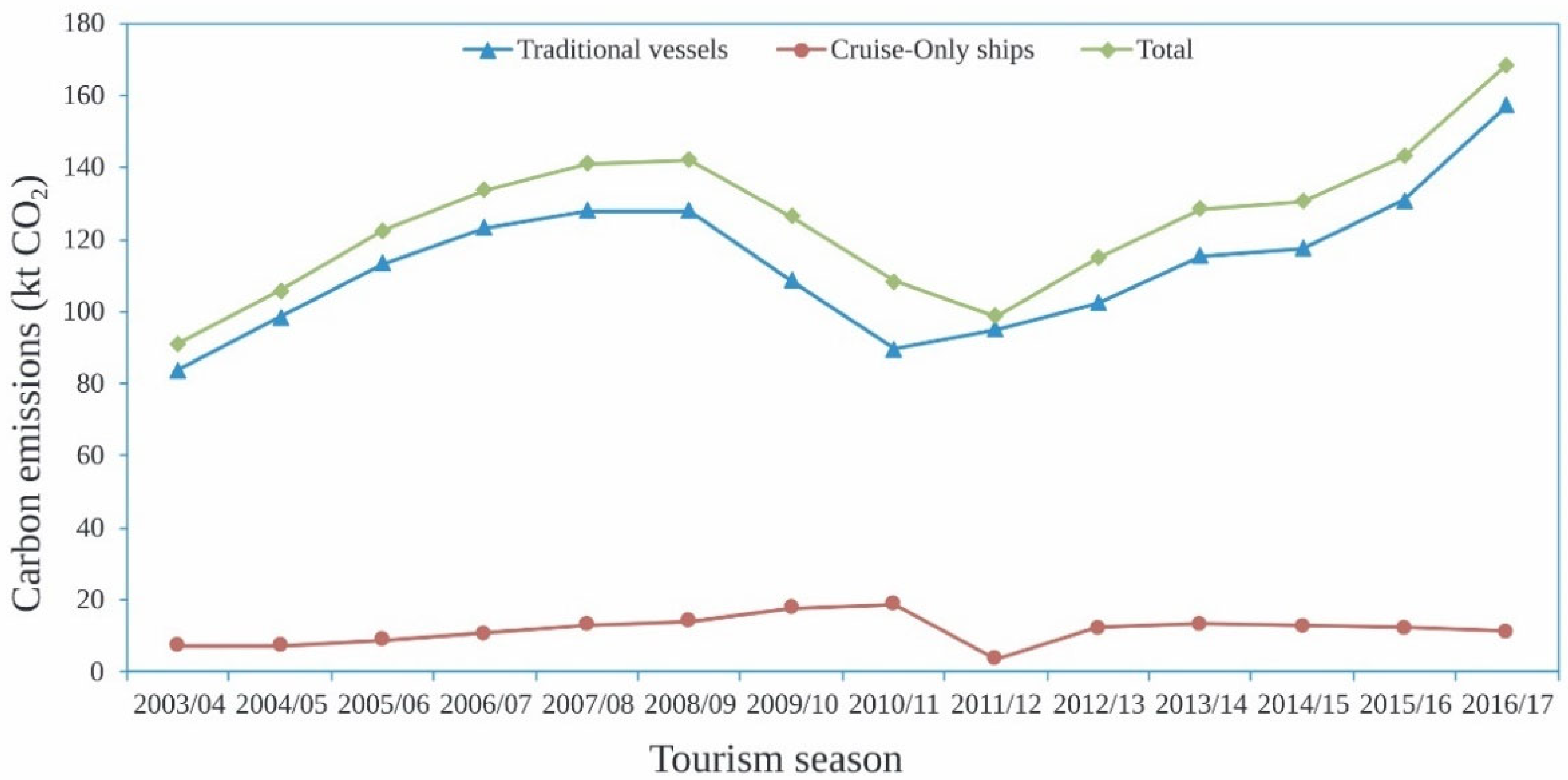
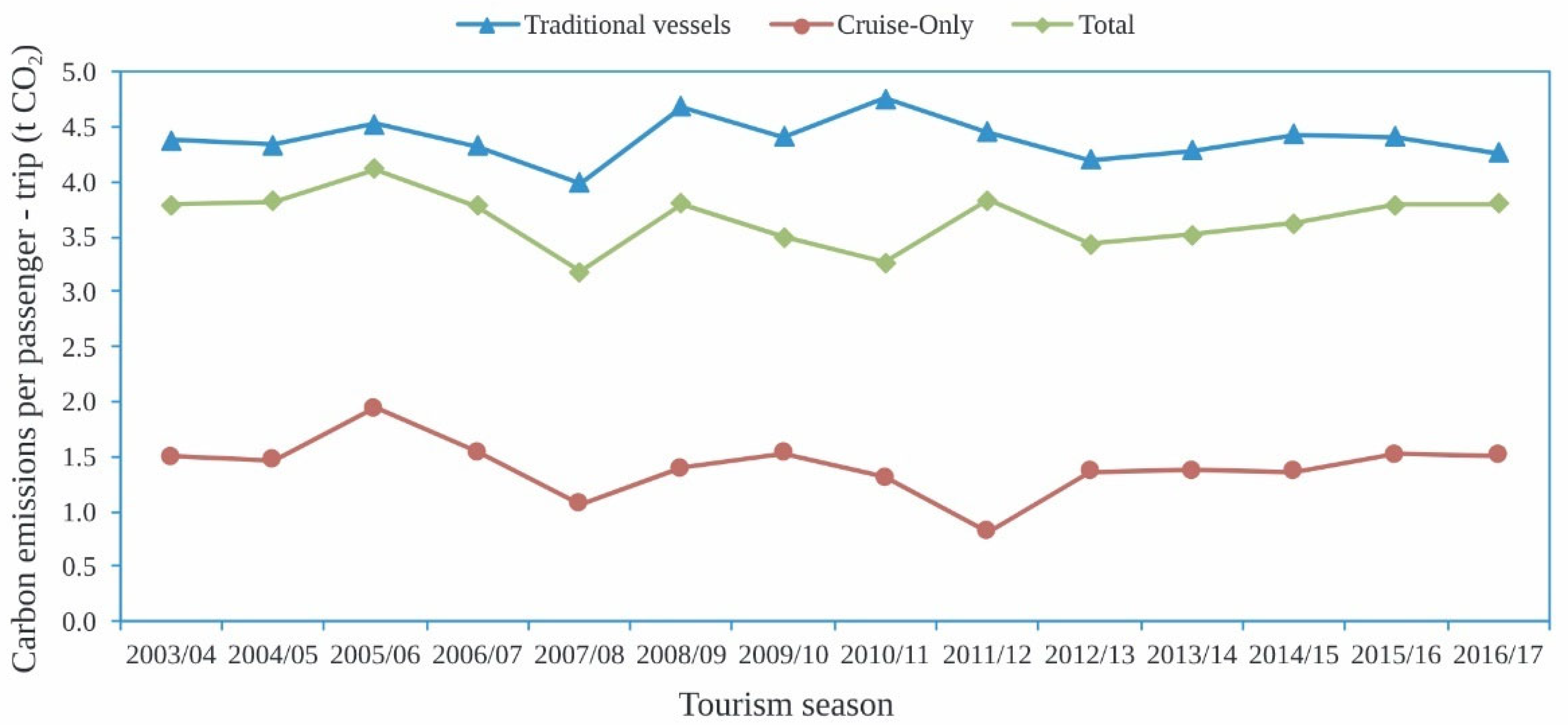

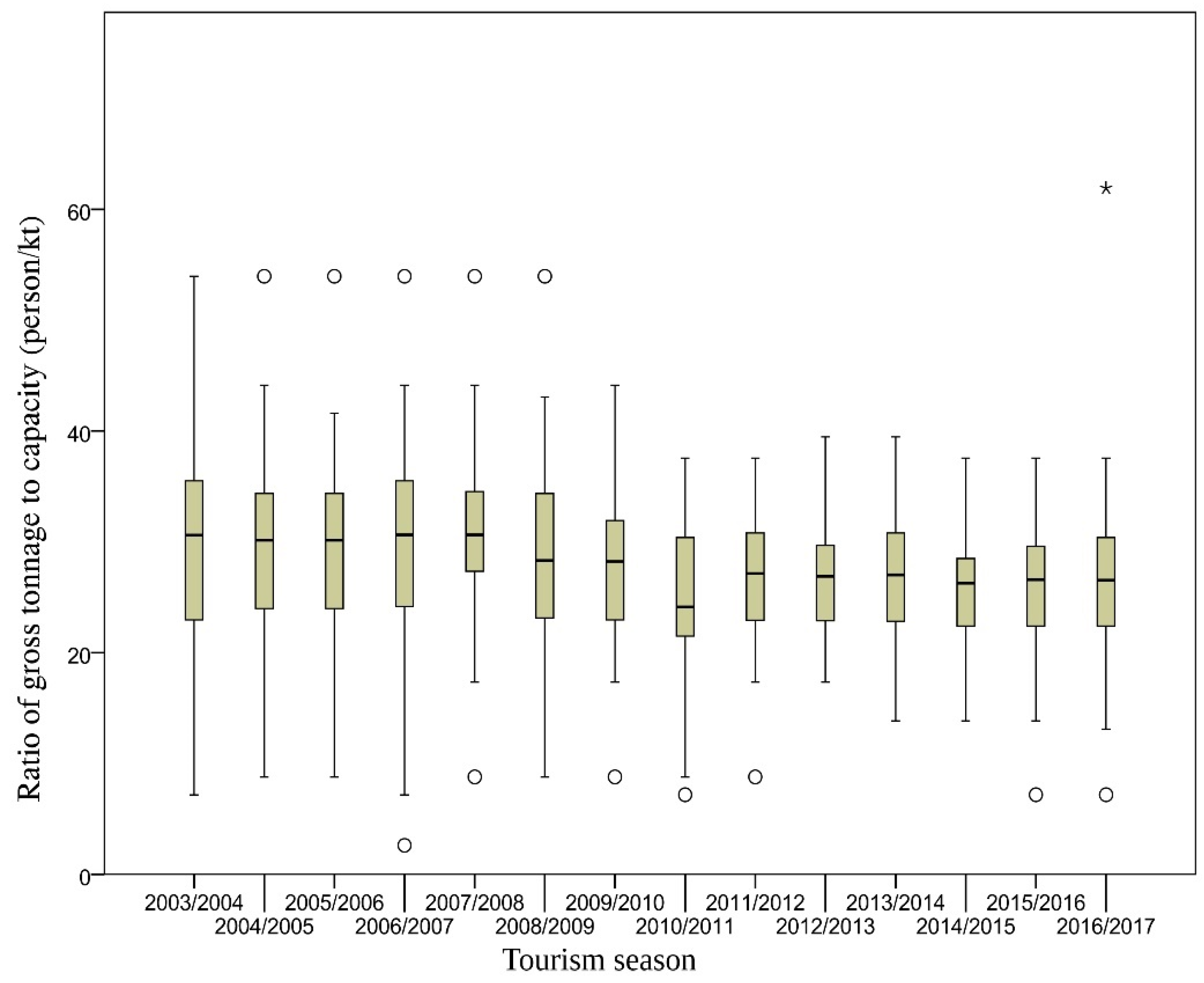

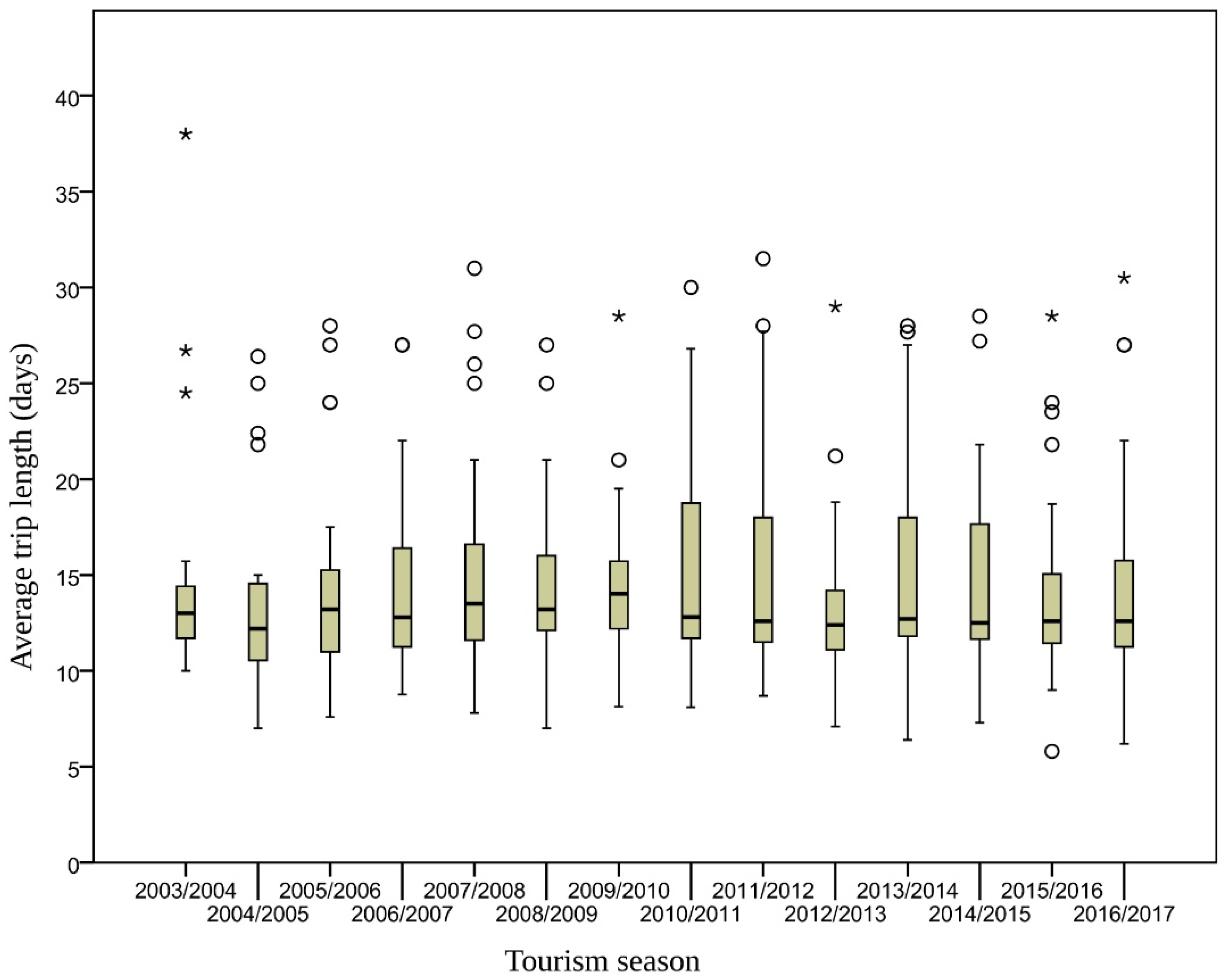
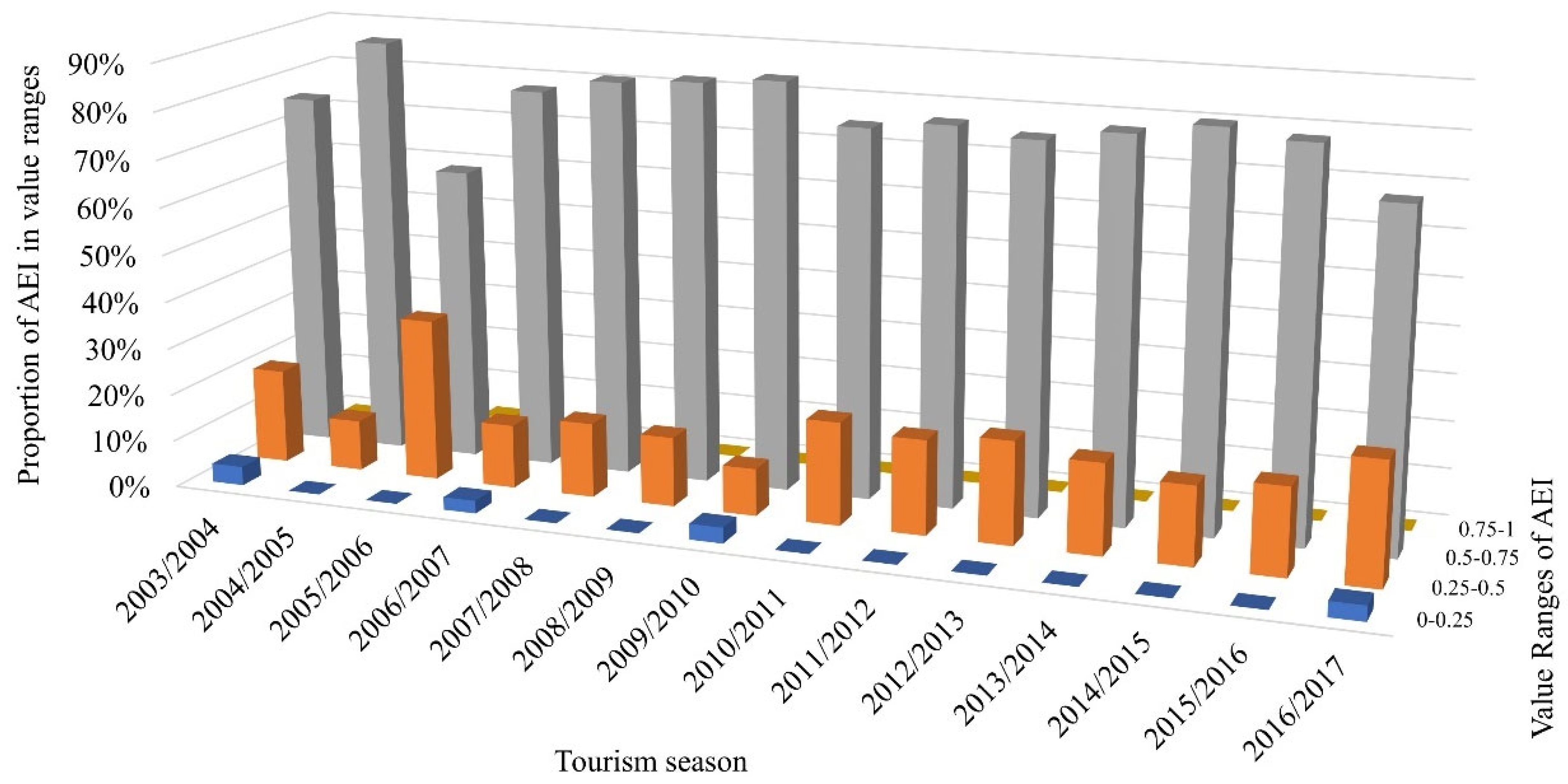
| Tourism Season | Number of Traditional Vessels | Number of Cruise-Only Ships | Total Number of Vessels | Passengers Via Traditional Vessels | Passengers Via Cruise-Only Ships | Total Number of Passengers |
|---|---|---|---|---|---|---|
| 2003/04 | 25 | 3 | 28 | 19,143 | 4939 | 24,082 |
| 2004/05 | 28 | 4 | 32 | 22,672 | 5024 | 27,696 |
| 2005/06 | 32 | 3 | 35 | 25,105 | 4632 | 29,737 |
| 2006/07 | 37 | 5 | 42 | 28,510 | 6930 | 35,440 |
| 2007/08 | 38 | 6 | 44 | 32,146 | 12,176 | 44,322 |
| 2008/09 | 34 | 4 | 38 | 27,313 | 10,090 | 37,403 |
| 2009/10 | 29 | 7 | 36 | 24,671 | 11,522 | 36,193 |
| 2010/11 | 23 | 7 | 30 | 18,840 | 14,373 | 33,213 |
| 2011/12 | 25 | 3 | 28 | 21,387 | 4387 | 25,774 |
| 2012/13 | 23 | 4 | 27 | 24,357 | 9070 | 33,427 |
| 2013/14 | 26 | 4 | 30 | 26,954 | 9670 | 36,624 |
| 2014/15 | 24 | 4 | 28 | 26,538 | 9459 | 35,997 |
| 2015/16 | 27 | 4 | 31 | 29,638 | 8109 | 37,747 |
| 2016/17 | 31 | 4 | 35 | 36,883 | 7475 | 44,358 |
| 2017/18 | 34 | 4 | 38 | 43,691 | 14,440 | 58,131 |
| 2018/19 | 33 | 4 | 37 | 40,665 | 10,889 | 56,168 |
| 2019/20 | 36 | 6 | 42 | 49,806 | 18,506 | 74,401 |
Publisher’s Note: MDPI stays neutral with regard to jurisdictional claims in published maps and institutional affiliations. |
© 2022 by the authors. Licensee MDPI, Basel, Switzerland. This article is an open access article distributed under the terms and conditions of the Creative Commons Attribution (CC BY) license (https://creativecommons.org/licenses/by/4.0/).
Share and Cite
Li, G.; Li, W.; Dou, Y.; Wei, Y. Antarctic Shipborne Tourism: Carbon Emission and Mitigation Path. Energies 2022, 15, 7837. https://doi.org/10.3390/en15217837
Li G, Li W, Dou Y, Wei Y. Antarctic Shipborne Tourism: Carbon Emission and Mitigation Path. Energies. 2022; 15(21):7837. https://doi.org/10.3390/en15217837
Chicago/Turabian StyleLi, Guomin, Wei Li, Yinke Dou, and Yigang Wei. 2022. "Antarctic Shipborne Tourism: Carbon Emission and Mitigation Path" Energies 15, no. 21: 7837. https://doi.org/10.3390/en15217837
APA StyleLi, G., Li, W., Dou, Y., & Wei, Y. (2022). Antarctic Shipborne Tourism: Carbon Emission and Mitigation Path. Energies, 15(21), 7837. https://doi.org/10.3390/en15217837







